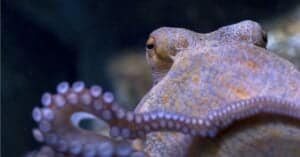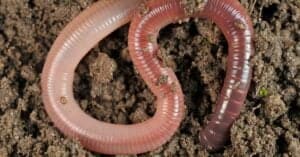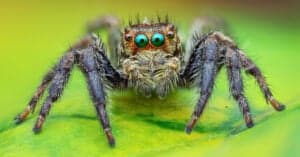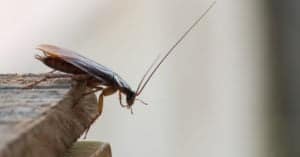Jellyfish vs Man O’ War: What Are 8 Key Differences?
@media (min-width: 481px) {
.mobile-top-content {
display: none;
}
}
#mobileTopContentCTACarouselControls { overflow: hidden; text-overflow: ellipsis; white-space: nowrap; }
.mobile-top-content .more { color: #fff; }
.mobile-top-content a { color: #fff; text-decoration: underline; }
.mobile-top-content a:hover { color: #fff; text-decoration: underline; }
@media (max-width: 480px) {
.mobile-top-content {
background-color: #06a10b;
color: #fff;
text-align: center;
/*height: 60px;
padding-top:5px;*/
font-size:80%;
/* display: block; */
margin: 0px -30px;
}
}
Although they are sometimes confused, the jellyfish and the Portuguese man o’ war are two different ocean creatures. They have tentacles, they sting, and they should be avoided at all costs in the sea. To the untrained eye, they are nearly identical. It may not seem important to know what makes them unique, but you never know when it can come in handy, especially if you are planning a visit to the beach soon!
Jellyfish vs Man O’ War: A Comparison

A-Z-Animals.com
| Jellyfish | Man O’ War | |
|---|---|---|
| Size | Average Width – 3 ft; Tentacles Up to 100 ft | Float – Up to 6 inches; Tentacles Up to 160 ft |
| Colors | Various Colors | Purple-Blue, Pinkish |
| Physical Features | 3 Parts: Umbrella, Oral Arms, and Stinging Tentacles | 4 Parts: Bladder, Tentacles, Digestive System, Sex Organs |
| Danger | Venomous; Pain Level Varies, Can Be Life-Threatening | Venomous; Incredibly Painful, Rarely Fatal |
| Diet | Passive Eater; Mainly Shrimp and Small Fish | Passive Eater; Small Fish, Plankton, Crustaceans, Worms |
| Lifespan | 1 – 3 Years, Some Species Much Longer | 1+ Years |
| Habitats | All Across the Worlds Oceans | Warm Waters; Atlantic and Pacific Oceans |
| Habits | Can Rise, Dive, and Swim – Floats via Belly Contractions | Floats and Feeds, Incapable of Swimming, Uses Ocean Currents |
Key Differences Between Jellyfish vs Man O’ War
The key differences between a jellyfish and a Portuguese man o’ war are size, appearance, physical features, lifespan, habits, habitats, and diet.
Although both are part of the phylum Cnidaria, the Portuguese man o’ war (Physalia physalis) is a species of siphonophore, which is a genus of creatures closely related to jellyfish. Jellyfish belong to the family Cyaneidae. Let’s explore some more key differences between these interesting sea creatures.
Jellyfish vs Man O’ War: Size

In size, jellyfish can range from one millimeter to 16 inches. When fully grown, the lion’s mane jellyfish (Cyanea capillata) can measure up to three feet across. Rarely they can reach a width of over 6 feet (1.8 m) and a length of over 100 feet (30 m) with their tentacles! Portuguese man o’ war’s feeding tentacles can measure up to 160 feet (50 meters) in length, and their float can measure up to 6 inches (15 centimeters).
Jellyfish vs Man O’ War: Colors
In terms of color, jellyfish can come in a wide range of hues from yellow to deep blue to vivid purple to pale lilac to bright orange to deep red. Luminescence is a term used to describe the icy, dazzling light that some jellyfish emit when disturbed at night. They are not able to change their color at will. Most of them will change color as they become older.
The blue, violet, or pink float of the man o’ war resembles a Portuguese naval ship under full sail from the 18th century, hence the name. A man o’ war’s bladder is a floaty blue, violet, or pink tint. Its color lets it blend in with the ocean’s water, surprising and stinging its prey.
Jellyfish vs Man O’ War: Physical Features
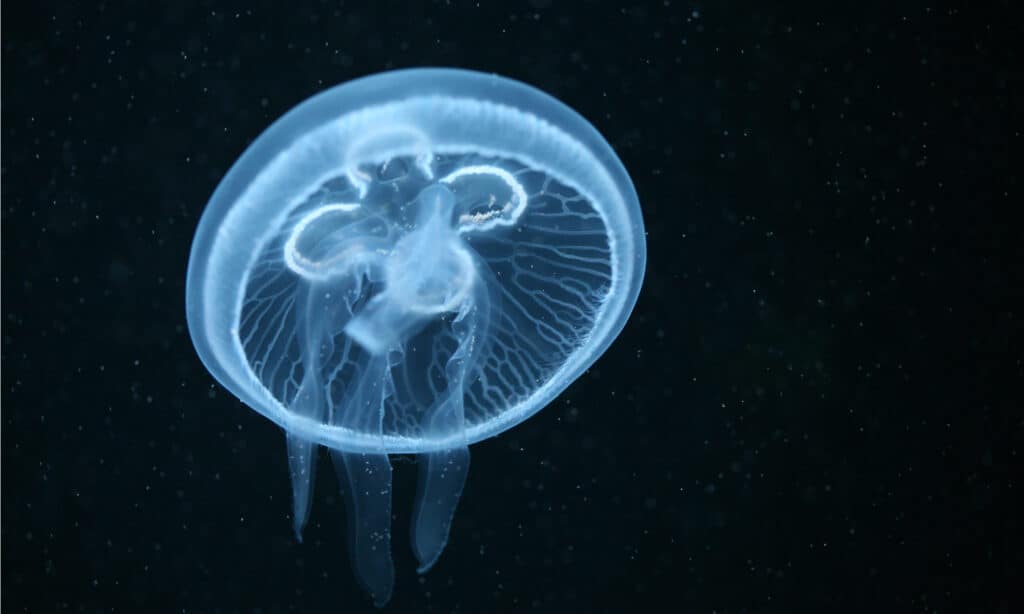
Vladimir Wrangel/Shutterstock.com
Having a smooth body with small tentacles, jellyfish can sting other organisms. They lack bones, brains, hearts, and eyes. These creatures’ mouths are in the center of their bodies. They are perfectly concealed by their body, which is 95% water! The umbrella, oral arms (around the mouth), and stinging tentacles are the three primary elements of a jellyfish’s body. They have an interior cavity for digestion.
The Portuguese man o’ war is a siphonophore, a group of specialized animals called zooids that act together. The uppermost polyp contains the gas-filled bladder; the second has the stinging tentacles covered in nematocysts; the third contains the muscle that moves food to the digestive system, and the fourth contains the reproductive organs. Individual colonies of man o’ war are made up of either all-female polyps or all-male polyps, depending on the species. Physalia utriculus, often known as bluebottles in the Pacific and Portuguese man o’ war in the Atlantic, is one of the most identifiable.
Jellyfish vs Man O’ War: Danger
Jellyfish stings are rarely life-threatening. Pain, redness, itching, numbness, and tingling are all common after a jellyfish sting. Some jellyfish stings, such as those from the marine wasp-like box jellyfish, are exceedingly severe and even lethal. In recognition of its status as the deadliest jellyfish in the ocean, the box jellyfish is one of the most hazardous creatures on Earth. There are numerous species of jellyfish in the box jellyfish family. Approximately 50 kinds of box jellyfish exist, some more hazardous than others.
Fish and other small animals can be paralyzed and killed by their poisoned nematocysts. However, Man-of-war stings, although incredibly painful for humans, are rarely fatal. A dead man o’ war that washes ashore might still sting. The venom can cause extreme discomfort in humans, as well as skin welts or an allergic reaction. If you see a Portuguese man o’ war, keep your distance and observe it from afar! If stung, monitor your symptoms and seek medical attention. Systemic reactions are not uncommon, but they are rarely life-threatening.
Jellyfish vs Man O’ War: Diet
With most jellyfish, feeding occurs in a “passive” fashion. This means that they float around the ocean, feeding on anything they can fit in their mouths, from tiny shrimp to small fish. The coelenteron is the jellyfish’s stomach and intestines in one place. Internal body cells create digestive enzymes that break down food that reaches the jellyfish’s intestine. Using these cells, the jellyfish can absorb and distribute nutrients throughout its entire system.
The Portuguese man o’ war is a carnivore that eats small fish, plankton, worms, and crustaceans. Rather than going out in search of food, the colony catches prey as it moves across the surface of the ocean.
Jellyfish vs Man O’ War: Lifespan
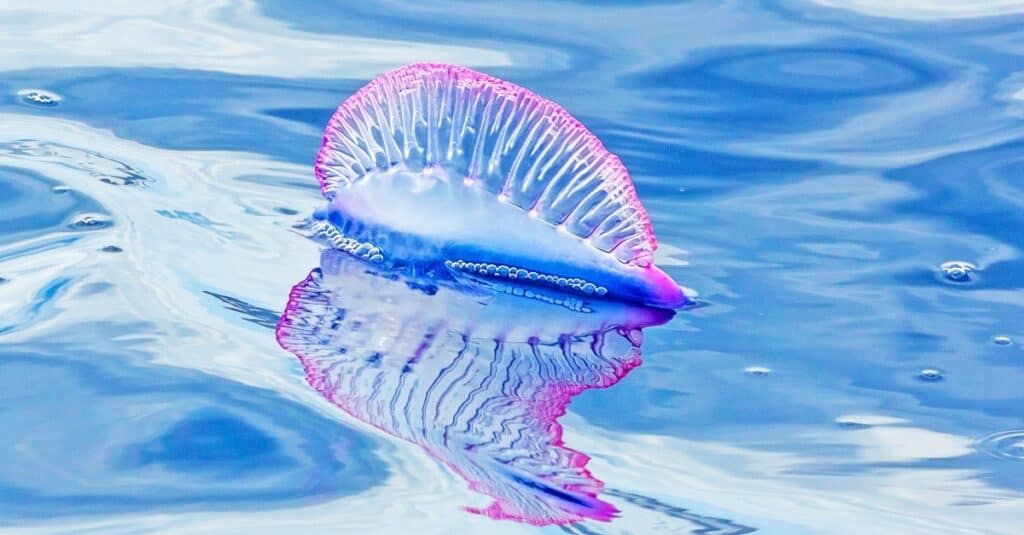
In general, the average life span of a Portuguese man o’ war is at least one year. The usual lifespan of a jellyfish is between one and three years. Some jellyfish species, on the other hand, can live for decades while others survive for only a few days.
Also, did you know that scientists have discovered some jellyfish may live endlessly? Known scientifically as Turritopsis dohrnii, the “immortal Jellyfish” can apparently live for a thousand years or more in the appropriate conditions. One reason for this is that, after reproduction, this jellyfish may revert to its “baby” stage (a juvenile polyp). Despite not being affected by aging, predators can nonetheless kill jellyfish.
Jellyfish vs Man O’ War: Habitat
The Portuguese man o’ war prefers the warmer waters of the tropics and subtropics. These colonies thrive in the warm waters of the Atlantic and Pacific oceans, including the Gulf Stream, the Indian Ocean, the Caribbean Sea, and the Sargasso Sea, where the water is warm enough for them.
Jellyfish can be found across the world’s oceans, from the depths of the deep sea to the wide waters of the open ocean and even the freezing waters of the Arctic. However, most jellyfish are found along coastlines. There are a variety of species that can be found in both fresh and saltwater environments.
Jellyfish vs Man O’ War: Habits
In response to sensory stimulation, jellyfish rise to the surface, dive to avoid rock walls, form aggregations, and swim horizontally in response to turbulent waters. They move ahead by rhythmically expanding and contracting their bellies (but aren’t powerful enough to withstand the direction of most ocean currents).
Portuguese man o’ wars are vicious predators. Small fish, pelagic crustaceans, and other invertebrates are stung and paralyzed by their feeding tentacles. Flotation, prey acquisition, feeding, and reproduction are just a few of the tasks that each of a man o’ war’s four distinct components is responsible for. The Portuguese man o’ war is incapable of swimming. Instead, it is propelled forward by the force of wind and ocean currents.
Wrapping Up Jellyfish vs Man O’ War
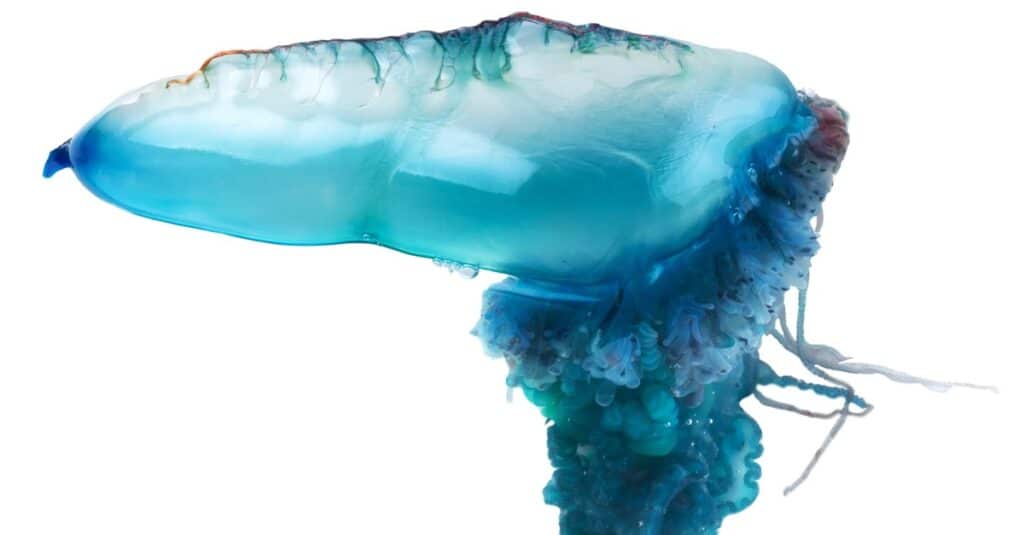
IrinaK/Shutterstock.com
It seems that the jellyfish and the man o’ war have a lot in common with one another. For example, their prey is easily stunned and captured by their stinging tentacles. Also, smaller species of fish and plankton are the primary sources of food for both species. Their parallels cease there, however. For example, jellyfish are classified as medusozoan, while Portuguese man o’ war belongs to the siphonophores family of creatures. The adults of the jellyfish species have a single gelatinous body; however, the man-of-war is made up of a cluster of four polyps that coexist.
More from A-Z Animals
.more-snake-card-image { max-height:140px !important; }
@media (min-width: 481px) {
.mobile-top-content {
display: none;
}
}
#mobileTopContentCTACarouselControls { overflow: hidden; text-overflow: ellipsis; white-space: nowrap; }
.mobile-top-content .more { color: #fff; }
.mobile-top-content a { color: #fff; text-decoration: underline; }
.mobile-top-content a:hover { color: #fff; text-decoration: underline; }
@media (max-width: 480px) {
.mobile-top-content {
background-color: #06a10b;
color: #fff;
text-align: center;
/*height: 60px;
padding-top:5px;*/
font-size:80%;
/* display: block; */
margin: 0px -30px;
}
}
Although they are sometimes confused, the jellyfish and the Portuguese man o’ war are two different ocean creatures. They have tentacles, they sting, and they should be avoided at all costs in the sea. To the untrained eye, they are nearly identical. It may not seem important to know what makes them unique, but you never know when it can come in handy, especially if you are planning a visit to the beach soon!
Jellyfish vs Man O’ War: A Comparison

A-Z-Animals.com
| Jellyfish | Man O’ War | |
|---|---|---|
| Size | Average Width – 3 ft; Tentacles Up to 100 ft | Float – Up to 6 inches; Tentacles Up to 160 ft |
| Colors | Various Colors | Purple-Blue, Pinkish |
| Physical Features | 3 Parts: Umbrella, Oral Arms, and Stinging Tentacles | 4 Parts: Bladder, Tentacles, Digestive System, Sex Organs |
| Danger | Venomous; Pain Level Varies, Can Be Life-Threatening | Venomous; Incredibly Painful, Rarely Fatal |
| Diet | Passive Eater; Mainly Shrimp and Small Fish | Passive Eater; Small Fish, Plankton, Crustaceans, Worms |
| Lifespan | 1 – 3 Years, Some Species Much Longer | 1+ Years |
| Habitats | All Across the Worlds Oceans | Warm Waters; Atlantic and Pacific Oceans |
| Habits | Can Rise, Dive, and Swim – Floats via Belly Contractions | Floats and Feeds, Incapable of Swimming, Uses Ocean Currents |
Key Differences Between Jellyfish vs Man O’ War
The key differences between a jellyfish and a Portuguese man o’ war are size, appearance, physical features, lifespan, habits, habitats, and diet.
Although both are part of the phylum Cnidaria, the Portuguese man o’ war (Physalia physalis) is a species of siphonophore, which is a genus of creatures closely related to jellyfish. Jellyfish belong to the family Cyaneidae. Let’s explore some more key differences between these interesting sea creatures.
Jellyfish vs Man O’ War: Size

In size, jellyfish can range from one millimeter to 16 inches. When fully grown, the lion’s mane jellyfish (Cyanea capillata) can measure up to three feet across. Rarely they can reach a width of over 6 feet (1.8 m) and a length of over 100 feet (30 m) with their tentacles! Portuguese man o’ war’s feeding tentacles can measure up to 160 feet (50 meters) in length, and their float can measure up to 6 inches (15 centimeters).
Jellyfish vs Man O’ War: Colors
In terms of color, jellyfish can come in a wide range of hues from yellow to deep blue to vivid purple to pale lilac to bright orange to deep red. Luminescence is a term used to describe the icy, dazzling light that some jellyfish emit when disturbed at night. They are not able to change their color at will. Most of them will change color as they become older.
The blue, violet, or pink float of the man o’ war resembles a Portuguese naval ship under full sail from the 18th century, hence the name. A man o’ war’s bladder is a floaty blue, violet, or pink tint. Its color lets it blend in with the ocean’s water, surprising and stinging its prey.
Jellyfish vs Man O’ War: Physical Features

Vladimir Wrangel/Shutterstock.com
Having a smooth body with small tentacles, jellyfish can sting other organisms. They lack bones, brains, hearts, and eyes. These creatures’ mouths are in the center of their bodies. They are perfectly concealed by their body, which is 95% water! The umbrella, oral arms (around the mouth), and stinging tentacles are the three primary elements of a jellyfish’s body. They have an interior cavity for digestion.
The Portuguese man o’ war is a siphonophore, a group of specialized animals called zooids that act together. The uppermost polyp contains the gas-filled bladder; the second has the stinging tentacles covered in nematocysts; the third contains the muscle that moves food to the digestive system, and the fourth contains the reproductive organs. Individual colonies of man o’ war are made up of either all-female polyps or all-male polyps, depending on the species. Physalia utriculus, often known as bluebottles in the Pacific and Portuguese man o’ war in the Atlantic, is one of the most identifiable.
Jellyfish vs Man O’ War: Danger
Jellyfish stings are rarely life-threatening. Pain, redness, itching, numbness, and tingling are all common after a jellyfish sting. Some jellyfish stings, such as those from the marine wasp-like box jellyfish, are exceedingly severe and even lethal. In recognition of its status as the deadliest jellyfish in the ocean, the box jellyfish is one of the most hazardous creatures on Earth. There are numerous species of jellyfish in the box jellyfish family. Approximately 50 kinds of box jellyfish exist, some more hazardous than others.
Fish and other small animals can be paralyzed and killed by their poisoned nematocysts. However, Man-of-war stings, although incredibly painful for humans, are rarely fatal. A dead man o’ war that washes ashore might still sting. The venom can cause extreme discomfort in humans, as well as skin welts or an allergic reaction. If you see a Portuguese man o’ war, keep your distance and observe it from afar! If stung, monitor your symptoms and seek medical attention. Systemic reactions are not uncommon, but they are rarely life-threatening.
Jellyfish vs Man O’ War: Diet
With most jellyfish, feeding occurs in a “passive” fashion. This means that they float around the ocean, feeding on anything they can fit in their mouths, from tiny shrimp to small fish. The coelenteron is the jellyfish’s stomach and intestines in one place. Internal body cells create digestive enzymes that break down food that reaches the jellyfish’s intestine. Using these cells, the jellyfish can absorb and distribute nutrients throughout its entire system.
The Portuguese man o’ war is a carnivore that eats small fish, plankton, worms, and crustaceans. Rather than going out in search of food, the colony catches prey as it moves across the surface of the ocean.
Jellyfish vs Man O’ War: Lifespan

In general, the average life span of a Portuguese man o’ war is at least one year. The usual lifespan of a jellyfish is between one and three years. Some jellyfish species, on the other hand, can live for decades while others survive for only a few days.
Also, did you know that scientists have discovered some jellyfish may live endlessly? Known scientifically as Turritopsis dohrnii, the “immortal Jellyfish” can apparently live for a thousand years or more in the appropriate conditions. One reason for this is that, after reproduction, this jellyfish may revert to its “baby” stage (a juvenile polyp). Despite not being affected by aging, predators can nonetheless kill jellyfish.
Jellyfish vs Man O’ War: Habitat
The Portuguese man o’ war prefers the warmer waters of the tropics and subtropics. These colonies thrive in the warm waters of the Atlantic and Pacific oceans, including the Gulf Stream, the Indian Ocean, the Caribbean Sea, and the Sargasso Sea, where the water is warm enough for them.
Jellyfish can be found across the world’s oceans, from the depths of the deep sea to the wide waters of the open ocean and even the freezing waters of the Arctic. However, most jellyfish are found along coastlines. There are a variety of species that can be found in both fresh and saltwater environments.
Jellyfish vs Man O’ War: Habits
In response to sensory stimulation, jellyfish rise to the surface, dive to avoid rock walls, form aggregations, and swim horizontally in response to turbulent waters. They move ahead by rhythmically expanding and contracting their bellies (but aren’t powerful enough to withstand the direction of most ocean currents).
Portuguese man o’ wars are vicious predators. Small fish, pelagic crustaceans, and other invertebrates are stung and paralyzed by their feeding tentacles. Flotation, prey acquisition, feeding, and reproduction are just a few of the tasks that each of a man o’ war’s four distinct components is responsible for. The Portuguese man o’ war is incapable of swimming. Instead, it is propelled forward by the force of wind and ocean currents.
Wrapping Up Jellyfish vs Man O’ War

IrinaK/Shutterstock.com
It seems that the jellyfish and the man o’ war have a lot in common with one another. For example, their prey is easily stunned and captured by their stinging tentacles. Also, smaller species of fish and plankton are the primary sources of food for both species. Their parallels cease there, however. For example, jellyfish are classified as medusozoan, while Portuguese man o’ war belongs to the siphonophores family of creatures. The adults of the jellyfish species have a single gelatinous body; however, the man-of-war is made up of a cluster of four polyps that coexist.

